Categories
Subjects
Authors
Artists
Venues
Locations
Calendar
Filter
Done
February 10, 2022 – Feature
Entering the Labyrinth: on Walid Raad’s “Two Drops per Heartbeat”
Julieta Aranda / Regine Basha
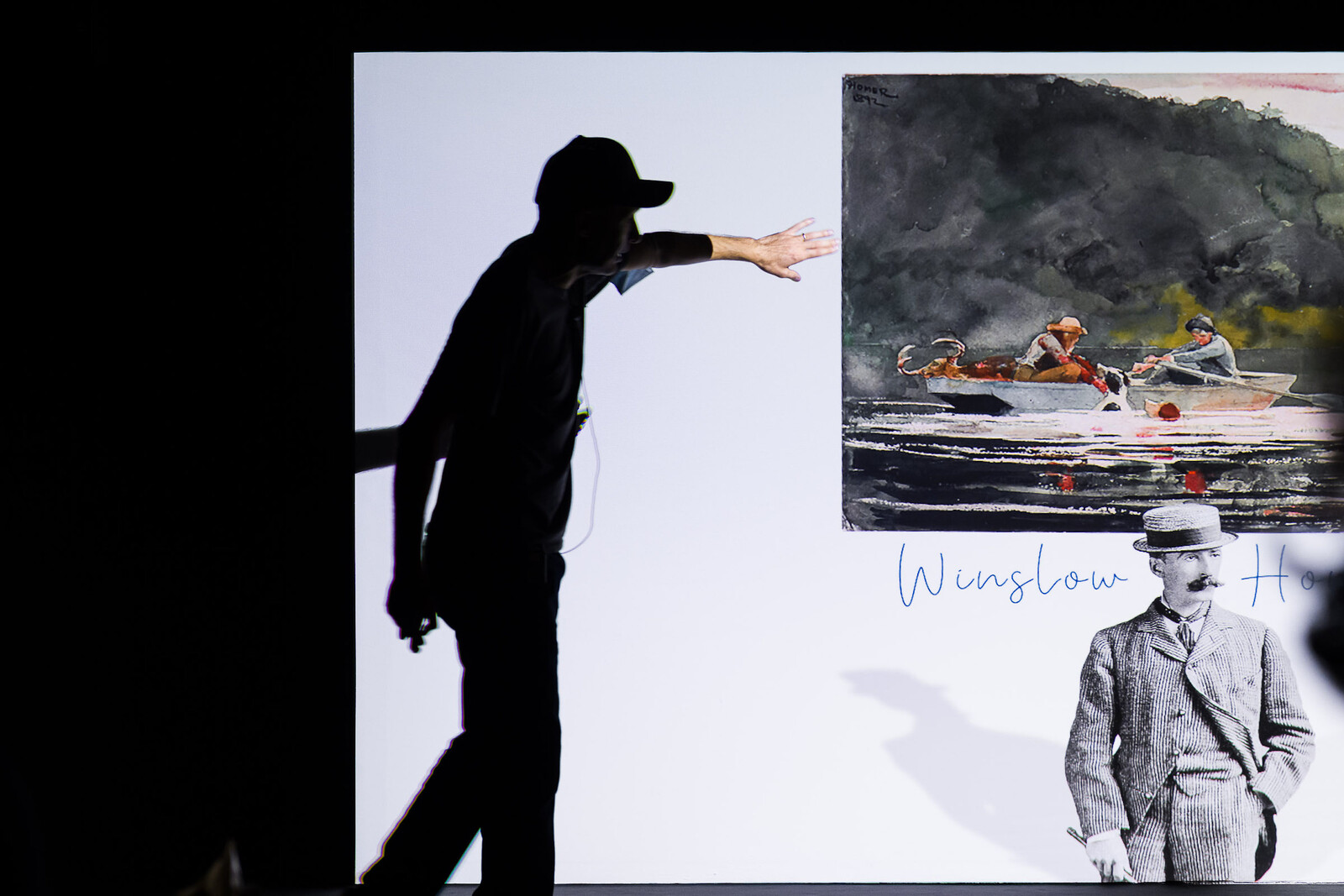
It was in 2007, in the setting of e-flux’s “United Nations Plaza” in Berlin, that we first met Walid Raad and Jalal Toufic, who were working as mentors at the alternative school. We learned then how they conspired (or co-inspired) together, with Toufic’s texts such as “Vampires” (2003) and “The Withdrawal of Tradition against a Surpassing Disaster” (1996) complementing Raad’s construction of cultural histories under the guise of the fictional preservation foundation The Atlas Group.
So when we learned that TBA21 Thyssen-Bornemisza Art Contemporary had commissioned Raad to create a new project around the history of the Thyssen-Bornemisza collection, we were naturally eager to see it. Having sharpened the methods and approaches pioneered with Toufic, Raad has produced a highly elaborate narrative intervention into the museum’s past. Titled “Cotton Under My Feet,” this investigation was paired with a 92-minute performative tour of the museum in the company of the artist called “Two Drops Per Heartbeat,” which took place a total of 67 times in the course of the show’s run.
The intervention focused, according to the show’s curator Daniela Zyman, on the events and documents around the sale, transfer, display, storage, and conditions of a collection that became one of …
January 23, 2020 – Review
“Defiant Muses: Delphine Seyrig and the Feminist Video Collectives in France in the 1970s and 1980s”
Barbara Casavecchia
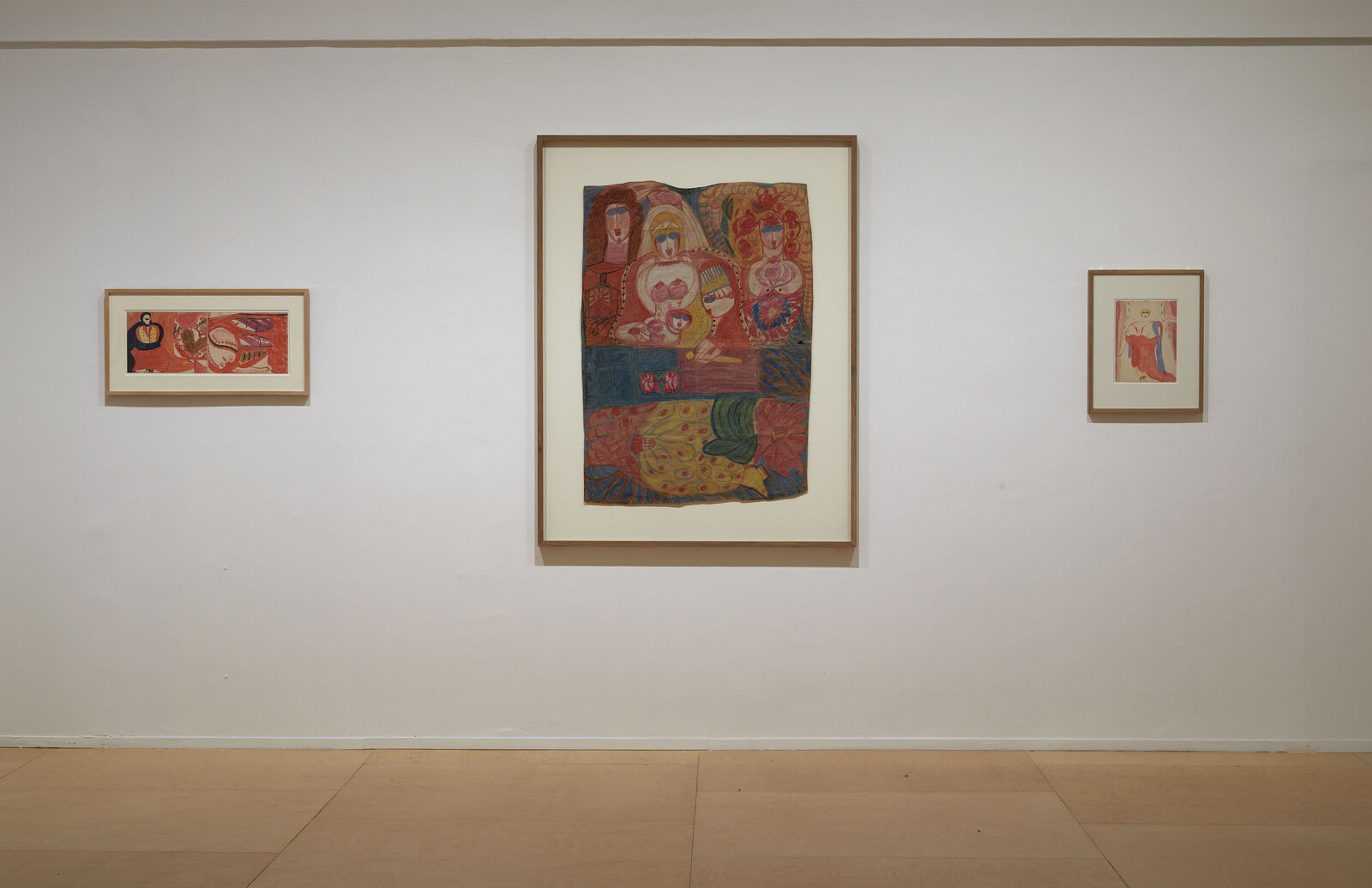
I was wrong. I walked into “Defiant Muses: Delphine Seyrig and the Feminist Video Collectives in France (1970s-1980s)” thinking the exhibition would be about “her” and “them,” and the past, only to realize that it is about “me” and “us,” right now. About sexism, silencing, inequality, discrimination, patriarchal oppression, rebellion, and about changing narrative paradigms. The show looks beyond Seyrig’s singular persona as “iconic” actress, to reconstruct, instead, a far fuller picture of her life and work as activist, feminist, director, and collaborator with a network of filmmakers who emerged from the MLF (Mouvement de libération des femmes). “Defiant Muses” revolves around the eternal question of how (and which) images are constructed and circulated, while interrogating the conflicts that emerge between acting a political position and translating it into personal action. Following Ariella Azoulay’s suggestion that archival documents “are not items of a completed past, but rather active elements of a present,” the exhibition rewrites history by reclaiming what gets suppressed. I spent hours in it, connecting the dots, shocked by how little I knew about these women’s stories, unsurprisingly, alas, themselves transmitted mostly by women.
Curated by Nataša Petrešin-Bachelez and Giovanna Zapperi, the show—which opened in July 2019 at …
April 18, 2019 – Review
Lynn Hershman Leeson’s “First Person Plural”
Stefanie Hessler

Who was Lynn Hershman Leeson between 1965 and 1994? The Centro de Arte Dos de Mayo (CA2M) in Móstoles, a city just southwest of Madrid, is showing “First Person Plural,” focusing on three decades of Hershman Leeson’s oeuvre. The exhibition pivots on questions of identity, technology, and the female, or rather woman-identified, body. As the title suggests, in sidestepping fixed notions of identity of herself as a person and as a woman artist, while considering cyborgian possibilities and the limits of technology, Hershman Leeson’s work today feels relevant and historical at once.
The first work on view in the modest-sized exhibition is The Electronic Diaries of Lynn Hershman Leeson (1984–96), distributed over four screens installed one behind the other. In these confessional and often disturbing video diaries, the artist films herself as she speaks directly to the camera, telling stories of her youth, physical and psychological abuse, binge eating, and trouble with self-acceptance, which are interspersed with sequences of news coverage. The connection of current affairs with diaristic accounts anchors the work in second-wave feminism’s assertion that the personal is political. For instance, a statement of Ronald Reagan dismissing the Iran-Contra affair is followed by Hershman Leeson’s ruminations on lying, betrayal, …
April 2, 2019 – Review
Madrid Roundup
Andrew Berardini

“Slightly shattered shards of substance thrown within the grasp of the current of a river / Ligeramente dañados pedazos de sustancia arrojados a la merced de la corriente de un río”: you read Lawrence Weiner’s writing in English and Spanish splattered across a wall as the flow of humans drags you through the endless booths of the art fair. (Was it Galería Horrach Moya from Palma de Mallorca? The tide moved too quickly to catch it.) You’re not sure if you’re the shards or the art is or you both are, but you know that the river is ARCOmadrid 2019. Spain’s biggest art fair has distinctive qualities. The giant convention center simultaneously hosts an air-conditioning convention, a huge concentration of Latin American galleries, planeloads of VIPs flown in for private conferences, along with a scatter of curated sections trying to find distinctive voices amongst the glut all the other fairs. Frieze LA last week, Armory next.
Into the limestone bench of RAPTURE (2017), Jenny Holzer carved “Rapture Screamed Toward the Clouds.” The poetic clarity and political force of Hauser & Wirth’s booth, dedicated to a survey of over 30 years of the artist’s work, set a mood. In MOVE (2015), …
July 26, 2018 – Review
Dora García’s “Second Time Around”
Sean O’Toole
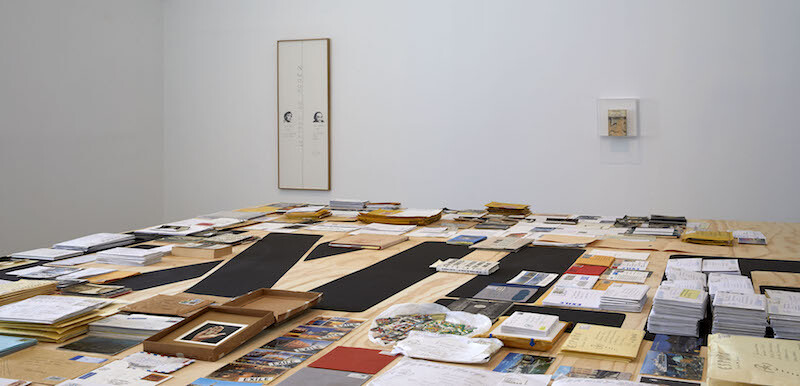
Among the artifacts assembled by curators Manuel Borja-Villel and Teresa Velázquez for their illuminating survey of Dora García’s work since 1997 are nine posters detailing the program for “The Inadequate” (2011), a 26-week investigation into radicalism, dissidence, and marginality staged by the artist in the Spanish Pavilion at the 54th Venice Biennale. The “occupation,” as García has referred to her Venice exhibition, commenced with a screening of Just Because Everything Is Different It Does Not Mean That Anything Has Changed (2008), an hour-length document of actor Harli Ammouchi performing imagined material by comedian Lenny Bruce, as well as various screenings, live performances, and public conversations. Some works were repeated, but The Inadequate was largely a durational event, one that was difficult to fully experience. I felt a similar sense of insufficiency visiting García’s Madrid show.
Even after two lengthy visits to the exhibition, which explores the fluid interplay between performance, film, and writing in García’s practice, there were films not fully watched, letters only parsed, and performances not wholly experienced. “Second Time Around” is a mosaic of temporalities. It invites frequent, purposeful encounters with its many and concurrently operating parts. Repetition doesn’t necessarily afford clarity. On the two days I visited, …
February 26, 2018 – Review
ARCOmadrid 2018
Lorena Muñoz-Alonso
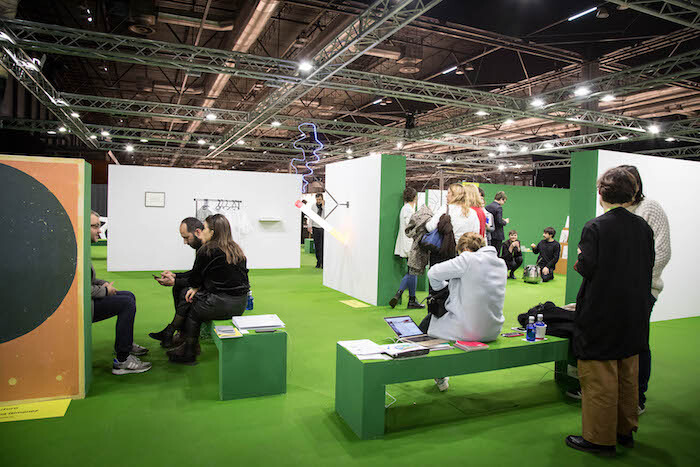
This year’s edition of ARCOmadrid embraced a temporal and conceptual gambit: the Future. It was, however, mostly corralled in the eponymous section at the fair, curated by Chus Martínez, Rosa Lleó, and Elise Lammer and featuring works by artists from 20 international galleries, including Nara Roesler, São Paulo; Union Pacific, London; Crèvecoeur, Paris; and A Gentil Carioca, Rio de Janeiro. The works were all installed in a booth-less platform, which made the viewing experience more akin to a group show than a traditional art fair. The elevated area, designed by architect and Manifesta 12 co-curator Andrés Jaque was carpeted with a bright green fabric—theater stage meets mini-golf course—which flattered the playful solo presentations. Eva Fàbregas’s installation for London’s Tenderpixel was generating plenty of attention on preview day. Featuring drawings, sound pieces, and large-scale inflatable sculptures sprawled on the floor and hanging from poles like giant millipedes, Picture Yourself as a Block of Melting Butter (2017) explored the dissolution of the body-object frontier through the lens of somatic experimentation, ASMR techniques, and the commodification of wellness.
Nearby at Berlin’s Chertlüdde, Alvaro Urbano’s sculptures, which borrow architectural elements from Archizoom’s Teatro Impossibile (Impossible Theatre, 1960) stood on the floor awaiting their activation on …
April 26, 2017 – Review
Donna Huanca’s “LENGUA DE BARTOLINA SISA”
Juan Canela
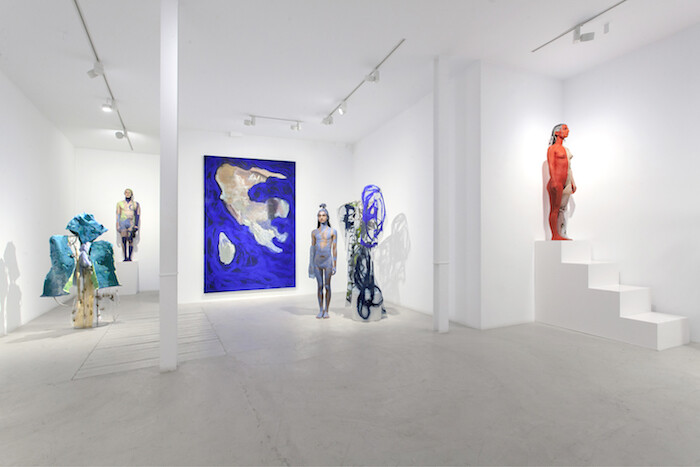
September 5, 1782. Bartolina Sisa, Aymara leader of the indigenous uprising against the Spanish in Bolivia, is brutally tortured, publicly humiliated, and killed by hanging. Her body is dismembered and, to prevent further rebellion, her head and extremities are exhibited at several locations known for their resilience. Bartolina Sisa has subsequently become a symbol for the struggle of indigenous populations throughout Latin America, and, since 1983, September 5 has been celebrated as International Day of Indigenous Women.
The title of the first exhibition by Bolivian-American artist Donna Huanca at Travesía Cuatro in Madrid refers to these facts, setting up a very precise symbolic framework. In recent years, Huanca’s work has stood out for its understanding of the body, and of the skin in particular, as a territory where surface and matter converse with architecture, space, and the world. Through paintings, sculptures, and performances, the artist creates disturbing futuristic-prehistoric scenarios where identity shatters into a sort of schizodynamic production of knowledge. In these performances, a set of actions is carried out by regular collaborators, producing slow-paced choreographies that conjure private rituals and meditations in the gallery space, confronting the viewer with a scenario equal parts uncomfortable and suggestive.
Last autumn, Huanca developed a …
September 27, 2016 – Feature
Madrid Roundup
Arielle Bier

In 2015, Spain’s Prime Minister Mariano Rajoy declared that the financial crisis, which began when global markets collapsed in 2008, was over, but that its legacy still endured. When recession hits, luxury goods dealers are among the first to panic, and the art market is no exception; luckily for Spain, government funding has kept cultural initiatives afloat. Even ARCOmadrid, the country’s main fair, which is one of the best attended in the world and comparatively hosts the most expensive VIP program, only managed to sidestep the recession because it is heavily subsidized. But beyond the temporary glamour and inflated sales reports, net profits on the global fair circuit are often meager, especially for small or mid-size galleries. This model is proving hard to sustain and puts the squeeze on gallerists to look for alternatives. This year, the seventh annual edition of Apertura Madrid Gallery Weekend, organized by the Art Galleries Association Arte_Madrid, substantially expanded its program in an effort to put Madrid’s gallery scene on the international map, bringing in for the first time collectors, curators, residency organizers, and journalists to visit over 43 solo and group exhibitions across the city.
Conversation about local versus global art networks arose multiple times …
February 25, 2016 – Review
Francesc Ruiz’s “Correos”
Mariana Cánepa Luna
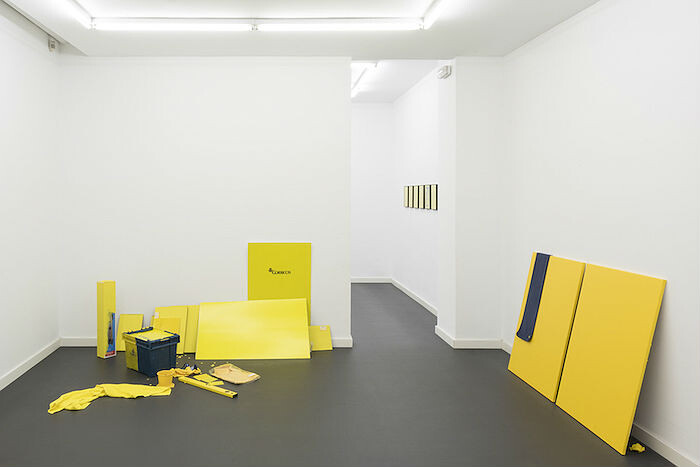
Francesc Ruiz’s second solo show at Madrid’s garcía galería delves into the visual communication of one of Spain’s most iconic institutions, the Sociedad Estatal Correos y Telégrafos—the national postal service, commonly known as Correos—whose graphic identity was created in 1977 by Spanish designer and artist José María Cruz Novillo (b. 1936). Ruiz’s interest is not limited to Cruz Novillo’s pervasive design, but more broadly includes Correos as an agent of distribution as well as the various commercial guises that come into play in this public service. Ruiz’s choice to focus this exhibition on the postal system, the pre-eminent pre-internet network, is not casual: through his characteristic strategy of “expanded comics” he has long been concerned with the potential of distribution and official versus alternative forms of circulation.
“To design is to designate,” Cruz Novillo once declared. Since the late 1960s, he has been largely responsible for the construction of a Spanish institutional iconography, allocating enduring visual identities to copious private and state-owned companies such as ministerial departments, Renfe (Spanish National Railway Network), the PSOE (Spanish Socialist Workers’ Party) or the former peseta bank notes, to name only a few. Conferring fresh new identities on institutions following 40 grim years of dictatorship, …
April 13, 2015 – Review
José Dávila’s “Actos tectónicos de duda y deseo”
Pablo Martínez
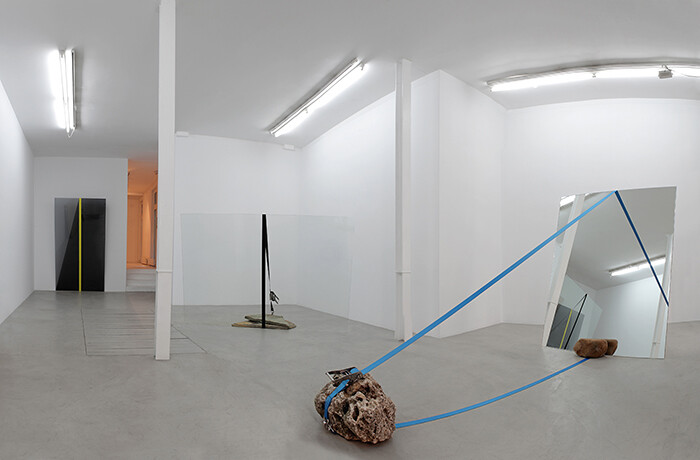
Behind every balance is a hidden tension—a negotiation between opposed bodies that equalizes their forces in order to form stability. There is, however, a permanent risk of falling, and imbalance occurs when one side shifts forces and disturbs the distribution of weight. Behind any image of equilibrium, one can glimpse fragility. Balanced structures generate systems of correspondence where the strength in tension contains conflict and mess.
To mark a decade of collaboration between the gallery and the artist, Travesía Cuatro exhibits the most recent works of José Dávila in what could be two shows in one, since what is on view corresponds to two very different series of the artist’s work. In the first room is a group of sculptures that seems to adhere more closely to the title of the show—“Actos tectónicos de duda y deseo” [Tectonic Acts of Doubt and Desire]: three pieces—and an additional one placed in the courtyard of the gallery—each titled Joint Effort (all 2015) made out of glass, boulders, and ratchet straps. For each work, the artist positioned a different kind of glass—mirrored, transparent, and tinted—next to a stone, using garishly colored commercial tie-down straps to contain the tension between these discrete objects.
The sculptures appear …
April 23, 2014 – Review
Teresa Margolles’s “El Testigo”
Octavio Zaya
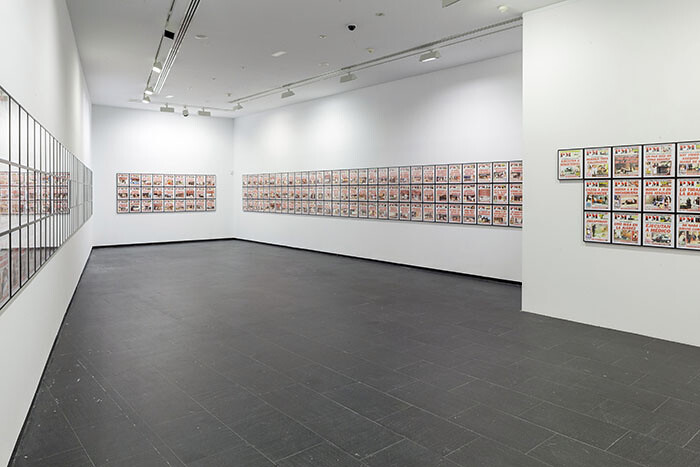
The testimony of the witness still has an important place among many artists and writers who identify their works with activist politics, dissidence, the subaltern, and the liberation strategies particularly favored in the last decade of the twentieth century. However, in these times, in which human testimony has been displaced from prominence by so-called material evidence, and in which psychology has given way to forensics, our attention seems to be directed away from the subjective aspects of evidence: the ambiguities and anxiety with which trauma and memory inevitably perfuse the account of the victim. This displacement is already pervasive in the field of law as much as it is in politics, the social sciences, and the entertainment industry, as we have increasingly seen with the influence of DNA, 3D scanners, and satellite surveillance, or in the popularity of the crime novels of Patricia Cornwell and Kathy Reichs, or the CSI television series. The current exhibition of Mexican artist Teresa Margolles at the Centro de Arte Dos de Mayo (CA2M) in Madrid embraces this cultural shift in unexpected ways, without placing itself outside the frame of testimony.
Curated by María Inés Rodríguez, Margolles’s “El Testigo,” which means “the witness,” is one of …
February 14, 2013 – Review
ARCOmadrid
Rosa Lleó
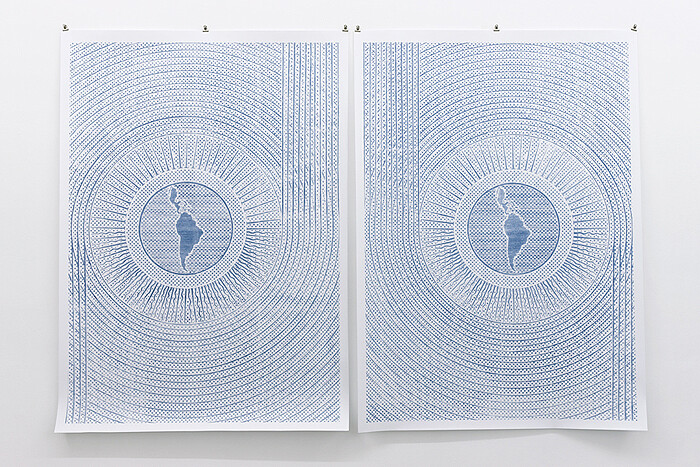
For a fair that has been around for thirty-two years, ARCO has weathered its share of ups and downs. Economic woes are at the root of the uncertain and gloomy mood that has reigned supreme in Spain’s cultural sector of late. Although the selection of galleries and visitors remains steadfastly international, many small businesses—galleries included—have been forced to shut down recently in the wake of the increase in taxes on cultural production in Spain, now at a whopping 21%. This reality haunts the current edition of ARCO. Nevertheless, one can say with relative confidence that considering the professional attendance and international perspective—focusing on the bridge between Europe and Latin America—ARCO has reached an apex. But this year’s real accomplishment is the savvy strategic investment of hosting a huge forum of “professional meetings,” for which almost every director of the most relevant museums and biennials worldwide has descended on Madrid to attend a series of working sessions by invitation only. Of this particularly high-caliber audience, one gallerist raved: “All of them are here. It has been like one continuous studio visit; the audience is better than that of a biennial!”
Besides the usual malaise that overcomes one after gaping at a floor …
February 17, 2012 – Review
ARCOmadrid
Lorena Muñoz-Alonso

This year’s edition of ARCOmadrid Art Fair was having none of the doom and gloom that usually accompany the fair. The Spanish art scene has tended to berate its most important and oldest art fair, a feeling which intensified when it was subject to management disagreements and ensuing conflicts with the galleries a couple of years ago. But the new team has honed an edition this year that people felt optimistic about. Whether in the national press or at the parties and events that heralded the fair’s openings, the mood was cautious but bright, even after ten hours of parading on a gray carpet and enduring the neon lights.
As I walked into the fair on a cold and sunny Wednesday morning, I was instantly reminded, with a sense of dread, of its colossal size. Inhaling deeply, map in hand, I headed directly to the Opening section on Hall 10, featuring twenty-five young galleries from all over Europe, carefully handpicked by Manuel Segade. The independent curator expressed his interest in showing underrepresented scenes, hence the inclusion of Eastern Europe’s gem Plan B and Ivan Gallery from Bucharest, or the Oslo-based gallery Imo. One pleasant surprise was the discovery of Figge von …
Load more
